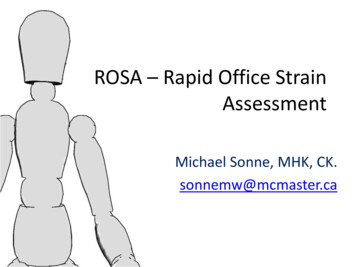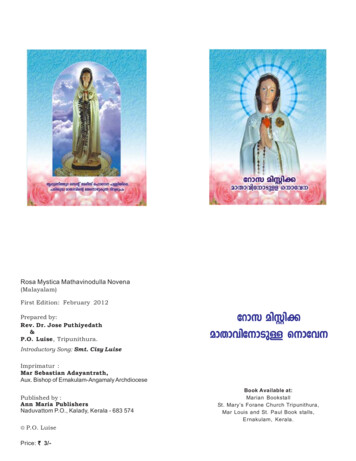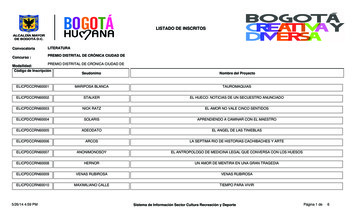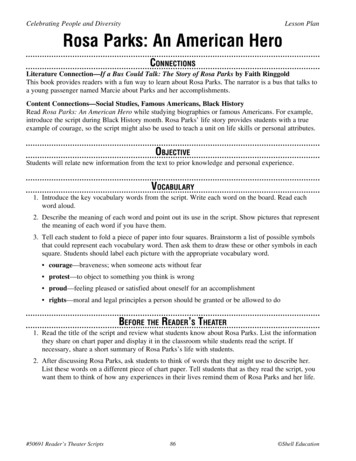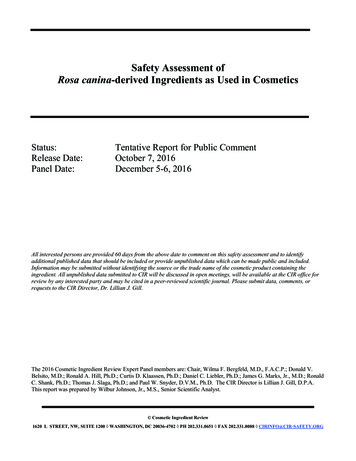
Transcription
Safety Assessment ofRosa canina-derived Ingredients as Used in CosmeticsStatus:Release Date:Panel Date:Tentative Report for Public CommentOctober 7, 2016December 5-6, 2016All interested persons are provided 60 days from the above date to comment on this safety assessment and to identifyadditional published data that should be included or provide unpublished data which can be made public and included.Information may be submitted without identifying the source or the trade name of the cosmetic product containing theingredient. All unpublished data submitted to CIR will be discussed in open meetings, will be available at the CIR office forreview by any interested party and may be cited in a peer-reviewed scientific journal. Please submit data, comments, orrequests to the CIR Director, Dr. Lillian J. Gill.The 2016 Cosmetic Ingredient Review Expert Panel members are: Chair, Wilma F. Bergfeld, M.D., F.A.C.P.; Donald V.Belsito, M.D.; Ronald A. Hill, Ph.D.; Curtis D. Klaassen, Ph.D.; Daniel C. Liebler, Ph.D.; James G. Marks, Jr., M.D.; RonaldC. Shank, Ph.D.; Thomas J. Slaga, Ph.D.; and Paul W. Snyder, D.V.M., Ph.D. The CIR Director is Lillian J. Gill, D.P.A.This report was prepared by Wilbur Johnson, Jr., M.S., Senior Scientific Analyst. Cosmetic Ingredient Review1620 L STREET, NW, SUITE 1200 WASHINGTON, DC 20036-4702 PH 202.331.0651 FAX 202.331.0088 CIRINFO@CIR-SAFETY.ORG
ABSTRACT: The Cosmetic Ingredient Review (CIR) Expert Panel (Panel) reviewed the safety of 12 Rosa canina-derivedingredients, which function as skin conditioning agents, fragrance ingredients, cosmetic astringents, anti-acne agents,abrasives, humectants, and exfoliants in cosmetic products. The Panel reviewed relevant data relating to the safety of theseingredients and concluded that these ingredients are safe in the present practices of use and concentration described in thissafety assessment when formulated to be non-irritating and non-sensitizing.INTRODUCTIONThe safety of the following 12 Rosa canina-derived ingredients as used in cosmetics is reviewed in this safetyassessment:Rosa Canina Fruit ExtractRosa Canina Bud ExtractRosa Canina FlowerRosa Canina Flower ExtractRosa Canina Flower PowderRosa Canina Flower OilRosa Canina Fruit (also known as rose hip)Rosa Canina Fruit JuiceRosa Canina Leaf ExtractRosa Canina SeedRosa Canina Seed ExtractRosa Canina Seed PowderAccording to the International Cosmetic Ingredient Dictionary and Handbook, Rosa Canina Fruit Extract is reportedto function as a skin conditioning agent in cosmetic products.1 Functions reported for other Rosa canina-derived ingredientsinclude: skin conditioning agent, fragrance ingredient, cosmetic astringent, antiacne agent, abrasive, humectant, and exfoliant(Table 1). Rosa Canina Flower Powder is reported to function as an anti-acne agent; however, function as an anti-acne agentis not a cosmetic use and therefore the Panel did not evaluate safety for that use.The Panel evaluated the safety of Rosa Canina Fruit Oil and other plant-derived fatty acid oils in cosmetics, andissued a final report in 2011 with the conclusion that these oils are safe in the present practices of use and concentration.3The Panel has also evaluated the safety of butylene glycol, which can be a major component of Rosa Canina Fruit Extract, incosmetics and issued a final report in 1985 with the conclusion that butylene glycol, hexylene glycol, ethoxydiglycol, anddipropylene glycol are safe as presently used in cosmetics.4 This conclusion was reaffirmed by the Panel in a 2006publication.5 Rosa Canina Fruit Extract contains 76.5% to 93.50% butylene glycol. 6 The Panel determined that, given the low useconcentration of Rosa Canina Fruit Extract in cosmetics (up to 0.25%), the concentration of butylene glycol in this ingredient isorders of magnitude lower than the maximum use concentration of butylene glycol ( 50%; considered a safe use concentration)that is stated in the published final report.CHEMISTRYPlant IdentificationRosa canina (also known as dog rose) is an herb that belongs to the Rosaceae family, and is among the plantsgrowing in Northeastern Portugal and in the Hadim, Taskent, and Ermenek regions of Turkey.7,8 Rose hip is a common namefor the dried fruit of Rosa canina. The definitions of Rosa canina-derived ingredients are presented in Table 1.1Chemical and Physical PropertiesThe chemical composition of Rosa Canina Fruit differs, depending on the cultivar, growing region, climate,maturity, cultivation practice, and storage conditions.15 Significant variations in the following components have beenreported: organic acids, sugars, water-soluble vitamins, minerals, and phenolics.11 The total phenolic content of Rosa caninahas been found to be 96 mg gallic acid equivalents (GAE)/g dry weight (DW), and the total fat content has been determinedto be 1.78%. The results of a fatty acid analysis indicated that Rosa canina contains the following 7 major fatty acids: lauricacid (4.8%), palmitic acid (16.4%), linoleic acid (16%), α-linolenic acid (40.5%), nonadecylic acid (4.74%), cis-C19:1ω6(5.79%), and cis-C22:2 ω6 (6.60%).15 The galactolipid, oyl]-3-O-β-Dgalactopyranosyl glycerol (GOPO) has been described as another important component of Rosa Canina Fruit.16
Additional information on the nutritional composition of wild Rosa Canina Fruit is presented in Table 4.15Rosa Canina Fruit ExtractUsing ultraviolet spectrophotometry, the λ max for Rosa Canina Fruit Extract (ethanol extract) has been reported at 280 nm.9Method of ManufactureRosa Canina Fruit ExtractThe part of the Rosa canina plant that is used to manufacture Rosa Canina Fruit Extract is the fruit without achene.Key steps in the manufacture of Rosa Canina Fruit Extract include: (1) solubilization of Rosa canina powder produced fromthe fruit without achene in a mixture of water and butylene glycol, (2) separation of soluble and insoluble phases, (3)clarification by filtration, (4) decoloration, and (5) filtrations and sterilizing filtration.6The method of manufacture of Rosa Canina Fruit Extract (ethanol extract) has been described as follows:9Dried raw material extract with 50 vol% ethanolic solution concentration adjustment sedimentation filtrate adjustment packagingbelow.9A description of the method of manufacture of Rosa Canina Fruit Extract (butylene glycol extract) is includedDried raw material extract with 1,3-butylene glycol filtrate sedimentation filtrate adjustment packagingFurther details relating to this method of manufacture were not provided.Composition/ImpuritiesRosa Canina FruitThe fruits of Rosa canina contain phenolic acids, proanthocyanidins, tannins, flavonoids, fatty acids, pectins,carotenoids, and fruit acids (ascorbic acid, malic acid, and citric acid).10 ( )-Catechin, a flavonoid, has been identified as themost abundant flavan-3-ol (3.59 mg/100 g) in Rosa Canina Fruits,7 and the abundance of ascorbic acid (Vitamin C, 880mg/100 ml) in Rosa Canina Fruit has also been noted.11,12Figure 1. ( )-Catechin and ascorbic acid (vitamin C)In addition to vitamin C, the following other nutrients in Rosa Canina Fruit have been reported: carotenoids, tocopherol,bioflavonoids, tannins, pectin, sugars, organic acids, amino acids, essential oils, phosphorus (P, 4860 ppm), potassium (K:5467 ppm), calcium (Ca: 2867 ppm), magnesium (Mg: 1254 ppm), iron (Fe: 27 ppm), copper (Cu: 27 ppm), manganese (Mn:56 ppm), and zinc (Zn: 30 ppm).11 According to another source, the following 6 main carotenoids have been identified inRosa Canina Fruit: epimers of neochrome, lutein, zeaxanthin, rubixanthin, lycopene, and β,β-carotene.13Three different brands of tea bag containing dried rose hip were mixed and pulverized and 0.5 g was obtained todetermine the presence of various elements.14 The following 14 elements were identified in the powder: Ca (18 ppm), Mg(1909 ppm), Fe (267 ppm), Al (157 ppm), Mn (244 ppm), Zn (22 ppm), Cu (5 ppm), Sr (59 ppm), Ba (47 ppm), Ni (2.9ppm), Cr (0.9 ppm), Co (0.4 ppm), Pb (0.3 ppm), and Cd (0.1 ppm); these elements were detected in tea (prepared from 0.5 g
rose hip in 25 mL water for 30 minutes at 95 C) in percentages of 6%, 72%, 14%, 4%, 20%, 28%, 60%, 25%, 52%, 25%,66%, 27% (% % of mineral originally found in dried rose hips), and not detectable, respectively.Rosa Canina Fruit ExtractRosa Canina Fruit Extract consists of 0.65% (maximum percentage) Rosa Canina Fruit Extract.6 Additionalinformation relating to the composition of this ingredient is found in Table 1. Composition data on Rosa Canina Fruit Extractare as follows: Rosa Canina Fruit Extract (maximum percentages: 0.45% to 0.65%), butylene glycol (maximum percentages:76.50% to 93.50%), and water (maximum percentages: 5.85% to 23.05%). Additional data relating to the composition of thedried matter of Rosa Canina Fruit Extract are: sugars (90%), mineral ashes (9%), and polyphenols (1%).Figure 2. Butylene glycolAn impurities analysis of Rosa Canina Fruit Extract for the following components was performed: allergens (26listed in European Regulation 1223/2009), alkaloids, aflatoxins (B1, B2, G1, and G2), and pesticides. These impurities werenot detected, i.e., all concentrations were lower than the threshold sensitivity of the method (not specified).6 A heavy metalsanalysis of Rosa Canina Fruit Extract indicated no traces of the following: cadmium, chromium, cobalt, mercury, andvanadium. However, traces of antimony, arsenic, nickel, lead, and selenium were found; less than 2 ppm of heavy metalswas reported.Rosa Canina Fruit Extract (ethanol extract or butylene glycol extract) has flavonoid and tannin components, mostprominently of which is the glycoside formed from the flavonoid quercetin, namely quercetrin.9Figure 3. QuercetrinAdditionally, Rosa Canina Fruit Extract (ethanol extract or butylene glycol extract) contains heavy metals (not more than 20ppm) and arsenic (not more than 2 ppm).9The highest concentration phenolic acid found in Rosa Canina Fruit Extract is Ellagic Acid.Figure 4. Ellagic AcidData relating to the content of some of the phenolic acids and flavonoids in various extracts of Rosa Canina Fruit arepresented in Table 2 and Table 3.17,18
Rosa Canina Bud ExtractFlavonols such as glycosides of quercetin and kaempferol, hydroxycinnamic acids, and ellagitannins were detectedin samples of Rosa Canina Bud Extract, with gallotannins being the main components (up to 1.7 g/L).19Rosa Canina Flower ExtractData on the composition of aromatic water obtained by hydrodistillation and dry distillation of Rosa canina flowers(distillate extracted with pentane) from Tunisia are presented in Table 5.20 This material is more closely related to a flowerwater ingredient type. The chemical constituents are presented in the order of lowest to highest retention index relative to nalkanes.Rosa Canina Leaf ExtractRosa Canina Leaf Extract contains alkaloids, flavonoids, glycosides, saponins, and a volatile oil.21 Data on thecomposition of essential oils obtained by hydrodistillation of Rosa canina leaves (distillate extracted with hexane,dichloromethane, and methanol) are presented in Table 6.22 This material is more closely related to a flower essential oilingredient type. The chemical constituents are presented in the order of lowest to highest retention index relative to C 9 -C 21n-alkanes.Rosa Canina SeedComposition data on Rosa Canina Seed from 3 growing regions in Turkey are available, and the highest reportedmean values for each component are presented in Table 7.8,23USECosmeticThe safety of the Rosa canina-derived ingredients included in this safety assessment is evaluated based on datareceived from the U.S. Food and Drug Administration (FDA) and the cosmetics industry on the expected use of theseingredients in cosmetics. Use frequencies of individual ingredients in cosmetics are collected from manufacturers andreported by cosmetic product category in FDA’s Voluntary Cosmetic Registration Program (VCRP) database. Useconcentration data are submitted by Industry in response to surveys, conducted by the Personal Care Products Council(Council), of maximum reported use concentrations by product category. Collectively, the use frequency and useconcentration data indicate that 7 of the 12 ingredients in this safety assessment are currently being used in cosmetic products(See Table 8). Based on these data, the following 5 ingredients are not being used in cosmetics:Rosa Canina Bud ExtractRosa Canina Flower OilRosa Canina Flower PowderRosa Canina Fruit JuiceRosa Canina SeedAccording to 2016 VCRP data, the greatest reported use frequency is for Rosa Canina Fruit Extract (342formulations, mostly leave-on products), followed by Rosa Canina Seed Extract (36 formulations, mostly leave-on products)(Table 8).24 The results of a concentration of use survey conducted in 2016 indicate that Rosa Canina Seed Extract has thehighest maximum concentration of use; it is used at concentrations up to 1.5% in leave-on products (lipstick) (Table 8).25 Insome cases, reported uses appear in the VCRP database, but concentrations of use data were not provided. For example,according to the VCRP, Rosa Canina Leaf Extract and Rosa Canina Seed Powder are being used in 7 and 6 cosmeticproducts, respectively; however, use concentration data on these ingredients were not provided in the concentration of usesurvey.Cosmetic products containing Rosa canina-derived ingredients may be applied to the skin and hair or,incidentally, may come in contact with the eyes (e.g., Rosa Canina Fruit Extract at maximum use concentrations up to 0.2%in eye area cosmetics) and mucous membranes (e.g., Rosa Canina Seed Extract at maximum use concentrations up to 1.5% inlipstick). Additionally, some of these ingredients are being used in products that may result in incidental ingestion. Forexample, Rosa Canina Seed Extract is being used in lipstick at maximum use concentrations up to 1.5%, Rosa Canina FlowerExtract is being used in lipstick at maximum use concentrations up to 0.04%, and Rosa Canina Fruit Extract is being used in
lipstick at maximum use concentrations up to 0.0015%. Products containing these ingredients may be applied as frequentlyas several times per day and may come in contact with the skin or hair for variable periods following application. Daily oroccasional use may extend over many years.Rosa Canina Fruit Extract is used in aerosol hair sprays at maximum use concentrations up to 0.0002% and in pumphair sprays at concentrations up to 0.25%; Rosa Canina Flower Extract is being used in pump hair sprays at maximum useconcentrations up to 0.001% and, in perfumes, at maximum use concentrations up to 0.01%. In practice, 95% to 99% of thedroplets/particles released from cosmetic sprays have aerodynamic equivalent diameters 10 µm, with propellant spraysyielding a greater fraction of droplets/particles below 10 µm, compared with pump sprays.26,27,28,29 Therefore, mostdroplets/particles incidentally inhaled from cosmetic sprays would be deposited in the nasopharyngeal and bronchial regionsand would not be respirable (i.e., they would not enter the lungs) to any appreciable amount.26,27 Rosa Canina Fruit Extract isalso being used in powders (dusting and talcum) at maximum use concentrations up to 0.01%, and in face powders atmaximum use concentrations up to 0.002%. Conservative estimates of inhalation exposures to respirable particles during theuse of loose powder cosmetic products are 400-fold to 1000-fold less than protective regulatory and guidance limits for inertairborne respirable particles in the workplace.30,31,32NoncosmeticAccording to FDA, rose fruit (hips) is generally recognized as safe for use in food for human consumption.33In traditional folk medicine, the petals, fruit, and leaves of Rosa canina are used in the treatment of variousdiseases/conditions, such as, nephritis, common cold, flu, coughing, bronchitis, eczema, itching, and biliary diseases.10 RosaCanina Fruit contains a wide range of bioactive compounds, including GOPO, vitamin C, phenolics, lycopene, lutein,zeaxanthin, and other carotenoids.15According to another source, a standardized powder of Rosa Canina Fruit is being marketed as an herbal remedy forthe treatment of pain in patients with osteoarthritis.34 Among the components of this powder is a mixture of 3 triterpene acids(oleanolic, ursolic, and betulinic acids).34,35TOXICOKINETIC STUDIESNo relevant published toxicokinetics studies on Rosa canina-derived ingredients were identified in a literaturesearch for these ingredients, and no unpublished data were submitted. Toxicokinetics data were not expected to be foundbecause each botanical ingredient is a mixture of many constituents.TOXICOLOGICAL STUDIESAcute Toxicity StudiesIntraperitonealRosa Canina Leaf ExtractThe acute intraperitoneal (i.p.) toxicity of Rosa Canina Leaf Extract (methanol extract) was evaluated using groupsof 5 albino mice.21 An estimated acute i.p. LD 50 of 455.19 23 mg/kg was reported. The animals exhibited toxic signs atdoses greater than the LD 50.Short-Term Toxicity StudiesOralAnimalRosa Canina Fruit ExtractRosa Canina Fruit Extract (aqueous extract diluted to 10% w/v, 500 mg/kg body weight/day) was administeredorally to 12 female brownish guinea pigs daily for 35 days.36 The vehicle control group (12 guinea pigs) received water. Thegeneral condition and behavior of all animals were described as normal, and body weight and food consumption in bothgroups were approximately the same.
HumanRosa Canina Fruit ExtractA double-blind, placebo-controlled clinical trial involving 2 groups of 16 subjects was performed.37 One groupreceived placebo tablets (1 per subject) and the other group received tablets containing Rosa Canina Fruit Extract (100 mg excipients, 1 per subject) once per day for 12 weeks. The Rosa Canina Fruit Extract tested was an aqueous ethanol extract ofRosa Canina Fruit containing its seeds, dextrin, cyclodextrin, and not less than 0.1% tiliroside (glycosidic flavonoid). Therewere no abnormalities, subjective symptoms, or findings suggesting clinical problems during the study.DEVELOPMENTAL AND REPRODUCTIVE TOXICITY (DART) STUDIESData on the reproductive and developmental toxicity of Rosa canina-derived ingredients were not found in thepublished literature, and unpublished data were not submitted.GENOTOXICITY STUDIESIn VitroRosa Canina Fruit ExtractThe genotoxicity of a product containing a maximum concentration of 0.65% Rosa Canina Fruit Extract wasevaluated in the Ames test (OECD Protocol #471) using Salmonella typhimurium strains (S. typhimurium strains not stated).6The product was evaluated at doses up to 5,000 µg/plate with and without metabolic activation. It was concluded that theproduct did not have mutagenic or pro-mutagenic activity in this assay.Ames test results for Rosa Canina Fruit Extract (butylene glycol extract) were negative.9 The testconcentrations/doses and bacterial strains tested were not stated. Rosa Canina Fruit Extract (butylene glycol extract) alsowas not genotoxic in the chromosome aberration test using the Chinese hamster lung cell line (CHL/IU). Details relating tothe test protocol were not provided.Rosa Canina Fruit Juice, Rosa Canina Leaf,and Rosa Canina SeedRosa Canina Fruit (unclear if Rosae pseudofructus cum or Rosae pseudofructus sine fructibus, Rosa canina L.,Rosaceae) was boiled at 100 C, stewed for 10 minutes, and then evaluated for genotoxicity in the Ames test.14,38 Raw, boiledjuice, boiled leaves, and dried seeds (concentration of each not stated) were not mutagenic in S. typhimurium strain TA 100.ANTI-GENOTOXICITY STUDIESIn VitroRosa Canina FruitIn an anti-genotoxicity assay, Rosa Canina Fruit (raw, concentration not stated) decreased the genotoxicity ofsodium azide by 44%.14,38Rosa Canina Fruit ExtractThe micronucleus test was used to evaluate the genotoxic effects of cypermethrin and fenvalerate (bothinsecticides); the effect of the water and ethanol extracts of Rosa Canina Fruit on the genotoxicity of these insecticides wasalso determined in this study.39
Using human peripheral lymphocyte cultures in vitro, cypermethrin was tested at concentrations of 20, 30, 40, and50 ppm, and fenvalerate was tested at concentrations of 25, 50, 75, and 100 ppm. Rosa Canina Fruit extracts were tested at aconcentration of 100 ppm. The negative control was dimethyl sulfoxide (DMSO, 1%), and ethyl methanesulfonate (1mM)served as the positive control. The Duncan test was used for statistical evaluation. For cypermethrin, the micronucleusfrequency was 1.275 at the highest test concentration, and the micronucleus frequency for fenvalerate was 1.6 at the highesttest concentration. Micronucleus frequencies were 0.725 and 2.7 for negative and positive controls, respectively. Thesedifferences between the experimental and DMSO control groups were statistically significant (p 0.05). In the genotoxicitytests with Rosa Canina Fruit Extracts, the micronucleus frequencies were as follows: 1.0 (cypermethin water extract),1.075 (cypermethin ethanol extract), 1.225 (fenvalerate water extract), and 1.275 (fenvalerate ethanol extract). Bothextracts (ethanol and water) of Rosa Canina Fruit caused statistically significant reductions (p 0.05) in the micronucleusfrequencies that were associated with insecticide exposure. It was concluded that the water and ethanol extracts of RosaCanina Fruit reduced the genotoxicity of both insecticides.CARCINOGENICITY STUDIESData on the carcinogenicity of Rosa canina-derived ingredients were not found in the published literature, andunpublished data were not submitted.OTHER RELEVANT STUDIESCytotoxicityRosa Canina Seed ExtractDried Rosa Canina Seed (100 g) was extracted with petroleum ether, 95% ethanol, or water, with yields of 0.3%,5.9% and 10%, respectively.14,40 The aqueous Rosa Canina Seed Extract had little cytotoxic effect on Yoshida ascitessarcoma cells (LC 50 10 mg/mL). However, the ethanol and petroleum ether extracts had a substantial cytotoxic effect onthese cells, with LC 50 s of 3.9 and 1.2 mg/mL, respectively. The authors noted that these results indicated a possible anticarcinogenic effect. However, this study did not involve testing to determine whether or not Rosa Canina Seed Extract(ethanol and petroleum ether extracts) is cytotoxic to normal cells.Effect on Skin PigmentationAnimalRosa Canina Fruit ExtractRosa Canina Fruit Extract (500 mg/kg body weight/day as aqueous extract, diluted to 10% w/v) was administeredorally to 12 female brownish guinea pigs daily for 35 days.36 The vehicle control group (12 guinea pigs) received water. Todevelop pigmentation, a 4 cm2 area of shaved skin was irradiated with 0.384 J/cm2 (0.8 mw/cm2 x 8 minutes) using a shortwave ultraviolet (290 to 320 nm; UVB) lamp on days 8, 10, and 12. The animals were killed on day 36. The skin lighteningeffect of Rosa Canina Fruit Extract was determined by measuring the “L*”value (lightness) with a reflectancespectrophotometer, and was evaluated quantitatively by determining the change in the L* value during the 35-day oral dosingperiod. Though the L* value of the irradiated area in the vehicle control group decreased substantially due to UVB-inducedpigmentation, the L* value in the experimental group was statistically significantly higher (compared to control) at each timepoint after irradiation. UVB-induced skin pigmentation was reduced after dosing with Rosa Canina Fruit; thus, the oraladministration of Rosa Canina Fruit Extract to brown guinea pigs caused inhibition of skin pigmentation. Proanthocyanidinsin Rosa Canina Fruit Extract was found to be the active principle responsible for the inhibitory effect on pigmentation ofguinea pig skin. It should be noted that, according to another study (in vitro), proanthocyanidins from grape seeds had noeffect on the expression of tyrosinase protein in normal human melanocytes.41In VitroRosa Canina Fruit ExtractThe effects of compounds isolated from a methanolic extract of Rosa Canina Fruit on melanin biosynthesis in B16mouse melanoma cells was investigated.42 Quercetin, one of the components isolated from Rosa Canina Fruit, was added to
the culture medium at concentrations of 10 µm, 20 µm, and 40 µm; the melanin content was reduced (compared to untreatedcontrol cells) in a dose-dependent manner to 64%, 34.5% , and 1%, respectively. It should be noted that, according toanother study, the enhancement of melanogenesis by quercetin has been observed in human melanoma cells (20 µMquercetin) and normal epidermal melanocytes (1 µM quercetin).43Rosa Canina Fruit Extract (aqueous extract) was added to B16 mouse melanoma cell cultures in vitro atconcentrations of 250 µg/ml, 500 µg/ml, and 1000 µg/ml to confirm its melanogenesis-inhibitory effect. Untreated culturesserved as negative controls. Additionally, arbutin (known inhibitor of melanogenesis) served as the positive control. RosaCanina Fruit Extract had an inhibitory effect on melanogenesis in mouse melanoma cells, having caused the followingconcentration-dependent reduction in melanin content when compared to negative control cultures: 65.6% at 250 µg/ml,37.8% at 500 µg/ml, and 19% at 1000 µg/ml. The reduction in melanin content occurred without any significantcytotoxicity.36Immune System EffectsNon-humanRosa Canina Fruit ExtractA study was performed to investigate the potential for Rosa Canina Fruit Extract (hydro-alcoholic extract) to induceimmunomodulatory activity using 45 rats (3 groups of 15).44 The 3 groups received normal saline (10 mg/kg), Rosa CaninaFruit Extract (250 mg/kg), and Rosa Canina Fruit Extract (500 mg/kg) orally, by gavage, daily for a period of 4 weeks.At Rosa Canina Fruit Extract doses of 250 mg/kg and 500 mg/kg, the gamma globulin level, neutrotrophil and monocytecounts, and phagocyte activity increased statistically significantly, when compared to the normal saline group. Lymphocytepercentages were statistically significantly decreased in treatment groups at weeks 2 and 3. On days 14 and 21, neutrophillevels increased in the 250 mg dose group. The phagocytic activity in both test groups was significantly higher, compared tothe control group, during all days of the study. There was no statistically significant difference in alanine aminotransferase(ALT), aspartate aminotransferase (AST), or alkaline phosphates (ALP) when compared to the control group. However,Rosa Canina Fruit Extract (both doses) statistically significantly increased thiobarbituric acid reactive substances (TBARS)and also decreased glutathione (GSH) levels when compared to the control group on day 28. It was concluded that RosaCanina Fruit Extract might have immunomodulatory effects, based on these data.DERMAL IRRITATION AND SENSITZATION STUDIESIrritation and SensitizationAnimalRosa Canina Fruit ExtractIn a skin irritation test involving 3 rabbits (strain not stated), results for the butylene glycol extract of Rosa CaninaFruit (0.3% solids – 100% of the butylene glycol extract) were negative.9 Details relating to the test protocol were notprovided.The skin sensitization potential of Rosa Canina Fruit Extract (butylene glycol extract) was evaluated using 10 guineapigs (strain not stated).9 The following concentrations of Rosa Canina Fruit Extract were tested: 4% and 20% of the originalsolution (0.3% solids) (1st induction), 20% of the original solution (2nd induction), and 4% and 20% of the original solution(challenge). Additional details relating to the test protocol were not presented. Test results were classified as negative.HumanRosa Canina Fruit ExtractThe skin irritation potential of a cosmetic product diluted to a maximum concentration of 0.0975% Rosa CaninaFruit Extract was evaluated using 10 adult subjects.6 The product was applied and left in place under an occlusive patch for48 h. Neither the location of the test site on the bodies of the subjects nor the concentration/dose per cm2 of the exposed skinwas stated. The product was classified as non-irritating.
In another study, the skin sensitization potential of the diluted product tested in the preceding study was evaluatedusing 110 normal volunteers in accordance with the method of Marzulli and Maibach.6 The product was applied to the backusing an occlusive patch with filter paper. The concentration/dose per cm2 of the exposed skin was not stated. The 3-weekinduction phase was followed by a 2-week non-treatment period and then a 1-week challenge phase. The product wasclassified as non-irritating and non-sensitizing.Rosa Canina Flower ExtractThe skin irritation and sensitization potential of a lip balm containing 0.04% Rosa Canina Flower Extract wasevaluated using 106 male and female healthy subjects.45 Approximately 0.2 g of the test substance was applied to the upperback (between the scapulae) using a 1" x 1" semi-occlusive patch, which remained in place for 24 h. Reactions were scoredat the time of patch removal and just prior to application of the next patch. The patches were applied 3 times per week for atotal of 9 induction applications. After a 2-week (approximately) non-treatment period, a challenge patch was applied for 24h to a new test site. Reactions were scored at 24 h and 72 h (or 120 h) post-application. The lip balm did not have skinirritation or sensitization potential in this study.In another study, the skin sensitization potential of a lip liner containing 0.018% Rosa Canina Flower Extract wasstudied using 202 healthy male and female subjects.46 The product (0.2 g) was applied to the infrascapular area of the backusing an occlusive patch or a semi-occlusive patch (each 2 cm x 2 cm). The test procedure was similar to that stated in thepreceding study, with the exceptions that induction reactions were scored at 48 h (or 72 h) post-application of the 24-hinduction patch, and challenge reactions were scored at 48 h
Oct 07, 2016 · According to the International Cosmetic Ingredient Dictionary and Handbook, Rosa Canina Fruit Extract is reported to function as a skin conditioning agent in cosmetic products. 1 Functions reported for other Rosa canina-derived ingredients include: skin conditioning agent, fragrance ingr

